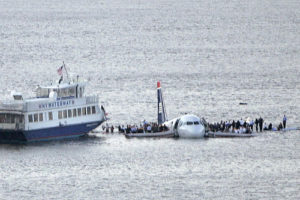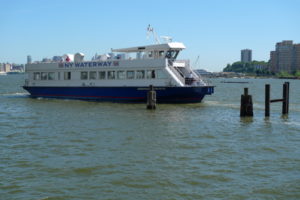
20 Feb 2015 How Fluidmesh Helped Increase Public Safety of New York Waterway
Years in operation
Shore-based installations
Ferry installations
After more than 25 years of operating ferry service from New York Harbour, New York Waterway faced an important question: How can we protect a fleet of ships and thousands of passengers every day without a fast ferry-to-ground connection? The ferries carry millions of passengers every year; but, without being connected, the majority of the ferry operator’s assets and passengers stayed in perpetual isolation. Consequently, communication capabilities were very limited, especially in the event of an emergency.
In order to provide fast information to passengers in an emergency situation, and increase communication with the Captain and gain real-time situational awareness of what is happening in and around the ships, a high-speed wireless connection from ship-to-shore was necessary. But this task was a daunting on in a densely populated area like New York City.
The ferry operator needed a robust network coverage area that would cover just about every waterway surrounding Manhattan, all complete with challenges ranging from water to ice, to three major nearby airports, to the constantly changing site lines and Fresnel zones. In addition, because the routes that ferries travel can change sometimes due to water conditions and traffic, the entire area would need to be connected, not only certain “corridors.”
The Problem
 Ferries have proven to be an essential source of redundant transit capacity in times of crisis in Manhattan, such as after the 1993 and 2001 attacks on the Twin Towers and the blackout during August, 2003. People around the world best remember the ferries for their role as first responders to the U.S. Airways “Miracle on the Hudson” plane downing in 2009.
Ferries have proven to be an essential source of redundant transit capacity in times of crisis in Manhattan, such as after the 1993 and 2001 attacks on the Twin Towers and the blackout during August, 2003. People around the world best remember the ferries for their role as first responders to the U.S. Airways “Miracle on the Hudson” plane downing in 2009.
NY Waterway enlisted the services of Fluidmesh Networks with the safety and security of its passengers in mind, to help them design and deploy a perfect wide-area wireless network and security solution to help improve emergency response, communications and preparedness throughout the ferry fleet.
Having ferries disconnected from communication with the mainland posed a critical risk for safety management, but, the ferry operator’s choices were limited.
When it comes to technology options for wide area networks that could support mobility, ferry companies have typically had two technology choices – satellite or cellular communication – both of which could not meet NY Waterway’s needs.
Satellite costs would have been prohibitive for covering of a wide area 24 hours/day. Cellular, on the other hand, couldn’t reach the ferry operator’s bandwidth requirements. Additionally, in most crisis management situations, cellular communication is not available, and therefore not a reliable solution in emergency recovery.
The Solution
NY Waterway clearly needed to find another way to connect their fleet. They turned to Fluidmesh, just as many government and private organisations for security, industrial backhaul and connectivity have , to deploy its high-bandwidth, secure wireless network products.
These networks, which work with a private and secured protocol invisible to normal 802.11 devices, can stream high-definition security video, enabling Internet access and a number of other applications. They have proven to be reliable during emergencies or at large events such as Super Bowl, concerts, and marathons, when cellular networks tend to get overwhelmed.
 But the Waterways project presented a different challenge, because previously, these private wireless networks were often limited to fixed, non-moving objects. In Waterways’ case, their ships were moving, so mobile connectivity was critical. In response to this technological challenge, Fluidmesh developed Fluidity™, a technology for connecting fast moving vehicles. The technology can be used to provide broadband connectivity to moving vehicles such as trains, metros, cars, and ferries. Fluidity™ delivers up to 100 Mbps of usable throughput up to 220 Mph and fully supports voice, video and data.
But the Waterways project presented a different challenge, because previously, these private wireless networks were often limited to fixed, non-moving objects. In Waterways’ case, their ships were moving, so mobile connectivity was critical. In response to this technological challenge, Fluidmesh developed Fluidity™, a technology for connecting fast moving vehicles. The technology can be used to provide broadband connectivity to moving vehicles such as trains, metros, cars, and ferries. Fluidity™ delivers up to 100 Mbps of usable throughput up to 220 Mph and fully supports voice, video and data.
NY Waterway chose the system to create high-speed wireless networks with connectivity for all its ports and ferries, which operate over a wide area spanning most of the East and Hudson Rivers, Upper New York Bay and Atlantic Highlands. To meet the challenge, Fluidmesh needed to design a network coverage area that included nearly every waterway surrounding Manhattan Island. The geography itself presents significant challenges for any radio frequency (RF)-based technology.
Fluidity enables NY Waterway to deploy redundant multi-tier mesh network infrastructures, meaning each ferry can be equipped with different wireless routers at the same time while the system leverages each router to select the best point-of-access per network infrastructure available at any point in each moment. This solution provides better coverage, redundancy and fault-tolerance. The system also supports multiple frequencies within the same network, which allows for important flexibility when working in crowded and dynamic RF areas like Manhattan.

Fluidmesh radios, which feature a small form factor that NY Waterway officials appreciated, were used along the shorelines. The network was deployed at 22 shore-based locations in New York and New Jersey and on 35 individual ferries.
The Fluidmesh Endo radio was selected for deployment aboard the ferries. The radio is designed for embedded applications, enabling the installer to mount the radio module and the antenna separately, thus allowing an omni-antenna to be used on the ships.
“To design Fluidity, we approached the mobility problem from a completely different point of view. Our goal was to build a solution not only suited for Internet browsing but for real-time streaming of video, voice and mission critical applications,” says Cosimo Malesci, Fluidmesh VP. “Mobility needs a complex network operations such as IP address negotiation, handoff and mesh infrastructure point-of-access selection. We took a completely new approach by designing, from the ground up, a cross-layer switching framework to completely hide these operations from user devices like cameras and VoIP phones.”
The result is a wide, reliable and fast connection between the ports and the ferries.